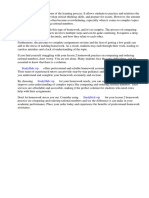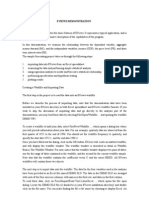Unit 2 Lecture Notes
Uploaded by
HennrocksUnit 2 Lecture Notes
Uploaded by
HennrocksLecture Notes for Chapter 5 Chapter 5, Introduction to Valuation: The Time Value of Money.
Is possibly the most important chapter in the entire course. This chapter introduces the concepts of compound interest and the manners in which to calculate every component of the compound interest formula. This will be the basic building block for most of the chapters we will cover subsequently. It is extremely important that you read the entire chapter with attention and that you understand every single concept presented. If you do not understand the material in this chapter, you will likely not understand the material in subsequent chapters. As always, if there is anything you have doubts on, please post a question to the Class Questions forum under the Discussion Board tab of our courses Blackboard site. In chapter 5, you are guided through the reasoning of the basic formula for calculating future value and are given numerous examples in which this formula or its derivations are used to calculate a solution.
The basic formula for future value is: FV = PV x (1+r) n
Where: PV = Present Value = the earlier amount on a time line FV = Future Value = the later amount on a time line r = Rate = the period rate (usually annual) expressed as a decimal n = Number of periods expressed in the same units as r In the example: How much is $100 deposited at 10% annual interest worth after 3 years? PV = $100 FV = Unknown r = 0.10 n=3 Using our basic formula: FV = 100 x (1.10)3 = $133.10 The basic FV formula is an equation with 4 terms (FV, PV, r and n). Knowing any 3 terms, you can solve for the remaining term. Rearranging the basic formula: PV = FV / ((1+r)n) r = ( FV / PV )1/n - 1 n = (ln(FV/PV))/(ln(1+r)) While these formulas are most commonly used in problems involving money and interest, they have multiple applications beyond this subject. For example, knowing that a certain botanical plant increases its height by one half each year, we want to know how tall a 12 inch plant will be 3 years from now. Once you recognize this problem as a compound interest problem, you can use our basic formula to solve it. The height of the plant in 3 years will be 12 x (1+0.5)3 = 40.5 inches. If you wanted to know how many years it would take the plant to grow to a height of 100 inches, you would use our formula for n and solve for n=(ln(100/12)/(ln(1+0.5)) = ln(8.3333)/ln(1.5) = 2.12/0.41 = 5.23. It will take our plant 5.23 years to grow to a height of 100 inches.
There are many ways to solve compound interest formulas: 1. Algebraically: As described above 2. Using PV and FV tables: Appendix A of your textbook contains a future value table and a present value table. The same tables have also been posted in a folder titled Mathematical Tables found in the Course Documents tab of BB. You use these tables by looking up the value of $1 for a certain number of periods (leftmost column going down) and for a certain rate (topmost row going sideways) then multiplying the value shown where your row and column intersect by your given PV (if finding FV) or FV (if finding PV). To find r or n, you look in the body of the FV table in the column of your given r (if finding n) or in the row of your given n (if finding r) for the number closest to your PV/FV. 3. Using a Financial Calculator: These calculators are designed for this purpose. While specific calculator steps vary, all financial calculators will let you input any 3 of the basic formulas terms and give you a result for the fourth (see pages 124 and 125 of your textbook for an example, but keep in mind that the precise steps required depend on the model of the calculator you are using). See the resources in the Course Documents tab of BB for one that has instructions for several different financial calculators. 4. Spreadsheet Programs. These typically have functions that calculate any term of the basic compound interest equation when given the other three. In Excel, these functions are: FV, PV, RATE and NPER (see page 137 of your textbook and the resources in the Course Documents tab of BB for some good material). 5. Online calculators: There are a number of online calculators that will let you input any 3 of the basic formulas terms and give you a result for the fourth (for an example see http://www.mathsisfun.com/money/compound-interest-calculator.html ). Regardless of the method you decide to use, it is extremely important that you know how to interpret a compound interest problem and how to calculate any one of the basic formulas terms when you know the other three. Common mistakes to avoid: Know when to express the rate as a percentage and when to express it as a decimal. Using the algebraic method, we always express r as a decimal (0.10 NOT 10%), however, different calculators, spreadsheets and online tools may require you to express the rate as a percentage (enter 10 if the rate is 10% NOT 0.10) Always express both number of periods and rate in the unit of measure equal to the compounding period. If given a 12% rate compounded monthly for one year, your n is 12 (months in a year) and your r is 0.01 (12% annual rate divided by 12 months in one year). If given a 4% quarterly rate compounded semi-annually for 3 years, your r is 8% (given rate of 4% quarterly times 2 quarters in a semi-annual period) and your n is 6 (number of semi-annual periods in 3 years). Test Your Understanding: It is highly recommended that after thoroughly reading and understanding chapter 5 you test yourself by attempting to solve problems 2,6,10,14 and 18 starting on page 141 of your
textbook. You can check your work against the answers listed on page C-1 at the end of the textbook or in the Course Documents tab of BB.
You might also like
- H4 ExpectedValue NormalDistribution SolutionNo ratings yetH4 ExpectedValue NormalDistribution Solution6 pages
- Quiz 1.04 Investment in Associate/Derivatives Submissions: Standalone AssignmentNo ratings yetQuiz 1.04 Investment in Associate/Derivatives Submissions: Standalone Assignment13 pages
- STAT14S - PSPP: Exercise Using PSPP To Explore Bivariate Linear RegressionNo ratings yetSTAT14S - PSPP: Exercise Using PSPP To Explore Bivariate Linear Regression4 pages
- Lesson 3 Homework Practice Solve Equations With Rational Coefficients Answers100% (1)Lesson 3 Homework Practice Solve Equations With Rational Coefficients Answers5 pages
- BUS MATH Q3 L4. SLeM - 2S - Q3 - W4 - RatioNo ratings yetBUS MATH Q3 L4. SLeM - 2S - Q3 - W4 - Ratio11 pages
- AP Physics 1 - Introductory Material: Standards of Measurement and PrefixesNo ratings yetAP Physics 1 - Introductory Material: Standards of Measurement and Prefixes9 pages
- Lesson 2 Homework Practice Compare and Order Rational Numbers100% (1)Lesson 2 Homework Practice Compare and Order Rational Numbers7 pages
- MTH001 Short Notes FAQs Short Questions AnswersNo ratings yetMTH001 Short Notes FAQs Short Questions Answers18 pages
- Linear Regression Analysis in Excel AssingmentNo ratings yetLinear Regression Analysis in Excel Assingment17 pages
- Econometrics Computer Exercise Week 1: Introduction Stata + Simple Regression ModelNo ratings yetEconometrics Computer Exercise Week 1: Introduction Stata + Simple Regression Model4 pages
- Weekly Overview: Week 2: Week 2: How Time and Interest Affect MoneyNo ratings yetWeekly Overview: Week 2: Week 2: How Time and Interest Affect Money4 pages
- BUSMATH 1 - Fractions, Decimals, and Percentages - KIMTIUNo ratings yetBUSMATH 1 - Fractions, Decimals, and Percentages - KIMTIU83 pages
- MS Excel Notes For CH 5 - FNC 240 - Fall 2022No ratings yetMS Excel Notes For CH 5 - FNC 240 - Fall 20224 pages
- Instructions Help Topics: Principles of Corporate Finance, 8th Edition Spreadsheet Templates MAIN MENU - Chapter 10No ratings yetInstructions Help Topics: Principles of Corporate Finance, 8th Edition Spreadsheet Templates MAIN MENU - Chapter 106 pages
- Chapter 2. The Time Value of Money: (Section 2.2)No ratings yetChapter 2. The Time Value of Money: (Section 2.2)35 pages
- Instructions: 1. Make Frequency Data RangesNo ratings yetInstructions: 1. Make Frequency Data Ranges11 pages
- Do This To Decide To Continue or Drop OutNo ratings yetDo This To Decide To Continue or Drop Out31 pages
- Student Solutions Manual for Mathematics for Economics, fourth editionFrom EverandStudent Solutions Manual for Mathematics for Economics, fourth editionNo ratings yet
- Lesson 1 Homework Practice Solve Equations With Rational Coefficients100% (1)Lesson 1 Homework Practice Solve Equations With Rational Coefficients6 pages
- Regular Payments Savings Plan: A Three Methods ApproachNo ratings yetRegular Payments Savings Plan: A Three Methods Approach2 pages
- formula pdf-to-be副本.pages - ACT_Math_FormulasNo ratings yetformula pdf-to-be副本.pages - ACT_Math_Formulas12 pages
- Help For Uncertainty Calculations Using The Evaluator ProgramNo ratings yetHelp For Uncertainty Calculations Using The Evaluator Program8 pages
- CUNY - Syllabus BUS 335 Operations Management SPRING 2014No ratings yetCUNY - Syllabus BUS 335 Operations Management SPRING 20145 pages
- The Effect of The Lehman Brothers Bankruptcy On State and Local GovernmentsNo ratings yetThe Effect of The Lehman Brothers Bankruptcy On State and Local Governments77 pages
- In The Financial Market There Are Four General Classifications of SecuritiesNo ratings yetIn The Financial Market There Are Four General Classifications of Securities2 pages
- Individual Assignment Questions On Time Value of MoneyNo ratings yetIndividual Assignment Questions On Time Value of Money6 pages
- Financial Management - RP Rustagi_CH 02No ratings yetFinancial Management - RP Rustagi_CH 0216 pages
- Learning Objective 26-1: Chapter 26 Capital Investment DecisionsNo ratings yetLearning Objective 26-1: Chapter 26 Capital Investment Decisions56 pages
- Foundations of Financial Planning - Overview& ProcessNo ratings yetFoundations of Financial Planning - Overview& Process90 pages
- Time Value of Money Time Value of MoneyNo ratings yetTime Value of Money Time Value of Money29 pages




































































































